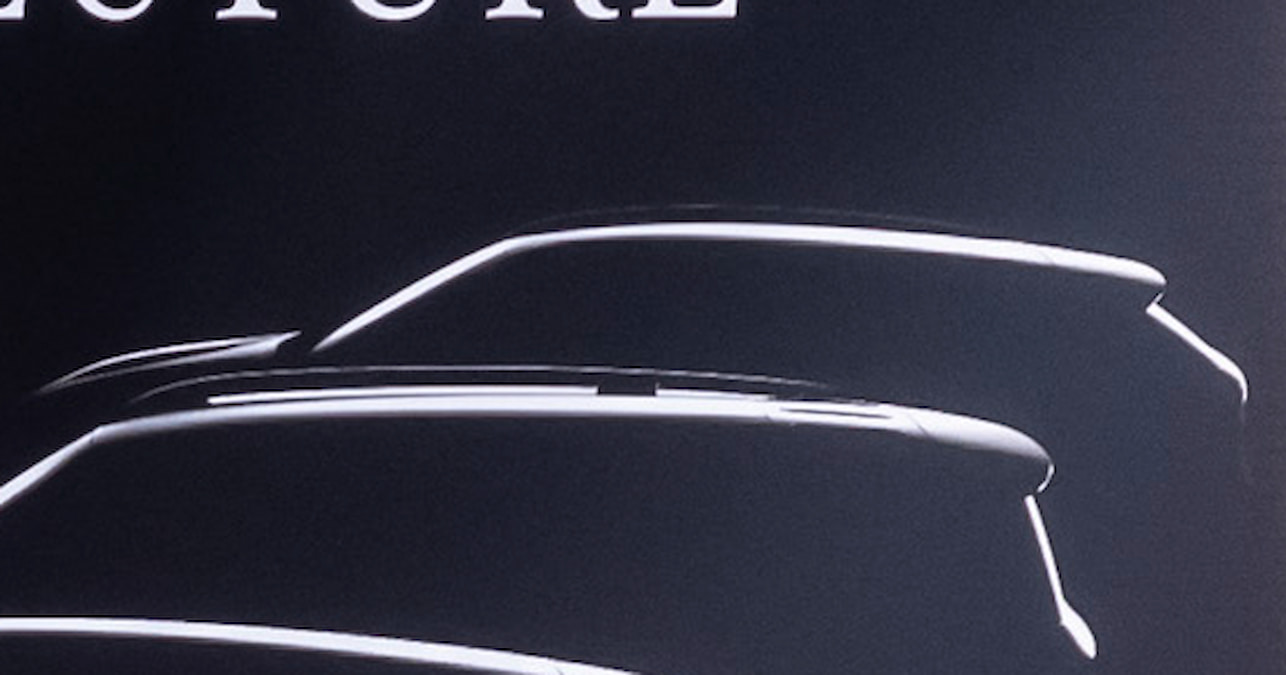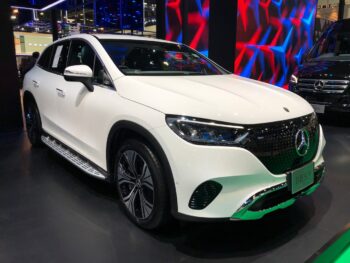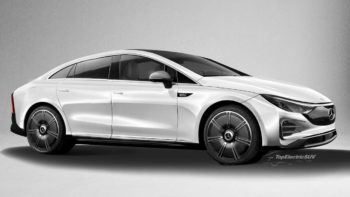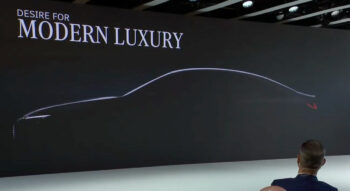Update: ‘Powertrain & Range’ sub-section of ‘Specifications’ updated.
Introduced in January 2021, the Mercedes EQA, the all-electric variant of the second-gen GLA, is just two and a half years old. However, Mercedes-Benz Group is already working on its successor, expected to be simply called Mercedes GLA Electric. Here’s everything we expect from the entry-level electric SUV.
Design
On September 3, 2023, Mercedes-Benz Group issued a teaser of its future compact model range, where it offered the first look at the Mercedes GLA Electric.
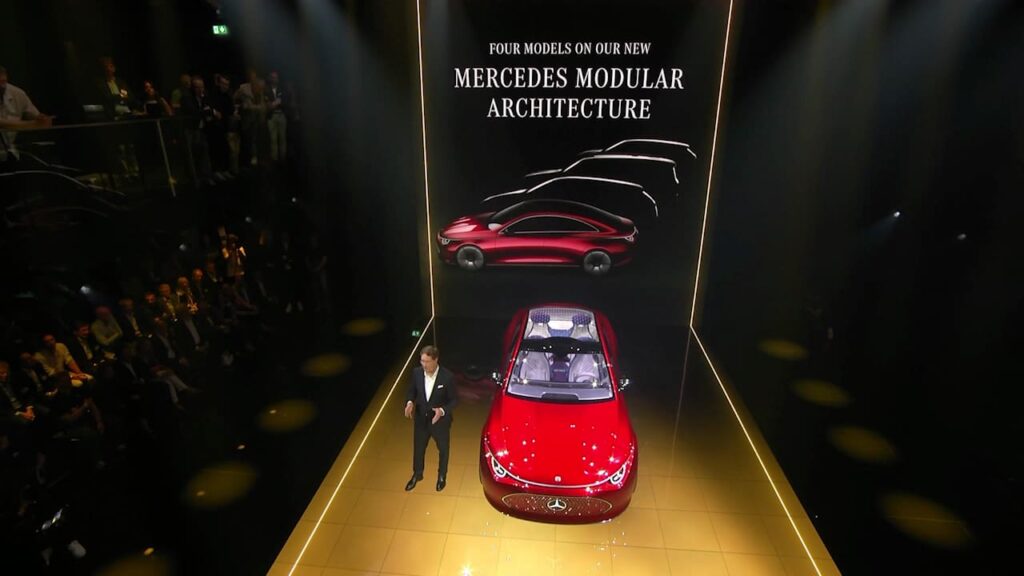
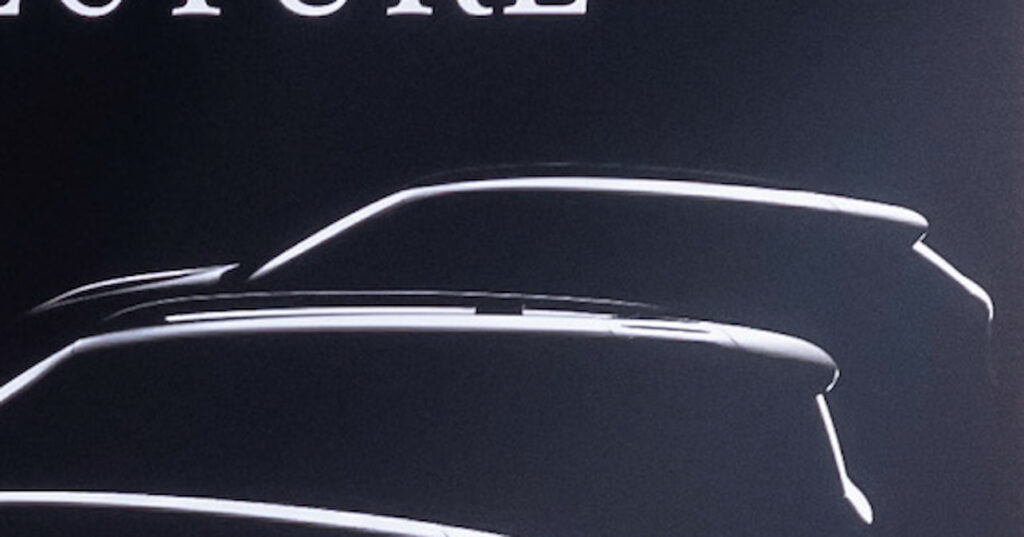
We expect the next-gen EQA to feature a more attractive front-end, with a reimagined closed grille, more sophisticated headlamps, a reshaped air intake, new side air inlets, and a more assertive bumper.
On the sides, the GLA Electric is expected to feature unique wheels, offered in various designs and sizes, possibly up to 20 inches. The generational shift will entail larger windows and a redesigned greenhouse. The teaser hints at a more raked D-pillar, which would lend the car a sportier character. A rugged bumper and high-tech-looking tail lamps may also be among the changes at the back.
We’re confident that the GLA Electric will be aerodynamically more efficient with new measures for reducing air resistance. Designers would try to streamline the grille, mirrors, and other body parts to achieve the highest possible energy efficiency.
Illuminated grille
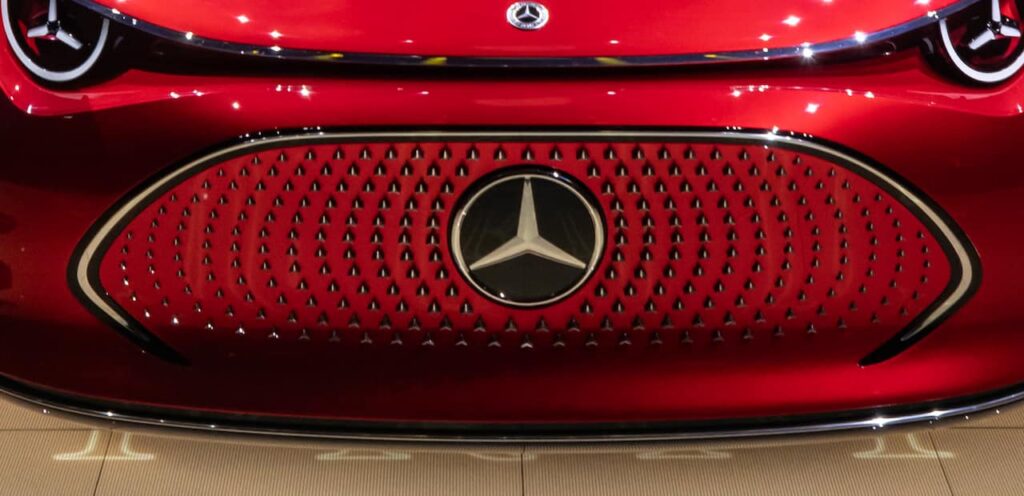
The Mercedes Concept CLA Class previews the design language of the brand’s future compact electric vehicles. In a report published by JESMB on March 25, 2023, it was reported that the production models will feature illuminated black panel grilles.
In place of a functional grille, expect sparkling stars to grace the smooth panel between the headlamps. Despite its compact dimensions and entry-level classification, these softly glowing and dimming stars would give the SUV style and road presence. Expected to be an optional feature, the illuminated grille could be one of the selling points of the GLA Electric.
Aero measures
Mercedes-Benz Group says that a typical EV consumes approximately 66.67% of its energy just pushing its way through the air. Even a reduction of 0.01 Cd leads to a significant difference in the range, of around 2.5%. For an EV delivering 400 km (249 miles) of range, it equates to an increase of 10 km (6 miles), which, although a smaller number, would be of significance when the battery pack is about to run out of charge, or considering the distance traveled by the vehicle through its lifetime.

Solar roof
The Mercedes GLA Electric may come with a solar roof that extends the range by charging the traction battery pack or contributes positively to reducing their energy consumption. The Mercedes Vision EQXX concept clearly indicates that is the vision. Mercedes-Benz Group R&D chief Markus Schäfer told journalists after the concept car’s unveil that the company will probably start offering solar panel roofs in series production models in 2024, as per an Autoblog report.
Specifications
Dimensions
Ola Källenius, CEO, Mercedes-Benz Group has suggested the Mercedes GLA Electric will be bigger than the current model. In the Mercedes-Benz Group 2021 results conference call, he said that an A-Class model will debut the MMA platform. Interestingly, the Swede also confirmed that not a single car based on the MMA platform will be shorter than 4 meters 50 centimeters (177.2 in.). For reference, the EQA measures 4,463 mm (4 meters 46 centimeters or 175.7 in.) in length.
Range
On September 3, 2023, at the Mercedes-Benz Group’s Pre-Night event for the IAA 2023, Källenius revealed that MMA EVs will have an 800-volt electric architecture and a two-speed transmission. These models will offer an improvement of more than 35% in the WLTP range over the currently sold MFA 2 platform-based EVs. The EQA can travel up to 532 km (331 miles) on a full charge, so the GLA Electric’s maximum range could be approximately 718 km (nearly 450 miles).
Mercedes-Benz Group is making its EVs more efficient, Källenius said. Thus, the increased range could be a result of not only improved batteries but also reduced energy consumption. For reference, the EQA that delivers a WLTP range of up to 532 km (331 miles) consumes as low as 15.3 kWh/100 km (15.3 kWh/100 mi), which will further reduce in the coming generation of models. Speaking of efficiency, Källenius said that “93% of the energy stored in the battery pack will actually arrive at the wheels.”
Battery
The scarcity and the resulting rising cost and supply shortage of Cobalt and Nickel have automakers rethinking their battery strategy. Källenius has said that the company is considering lithium-iron-phosphate batteries for entry-level models, Bloomberg reported on October 27, 2021.
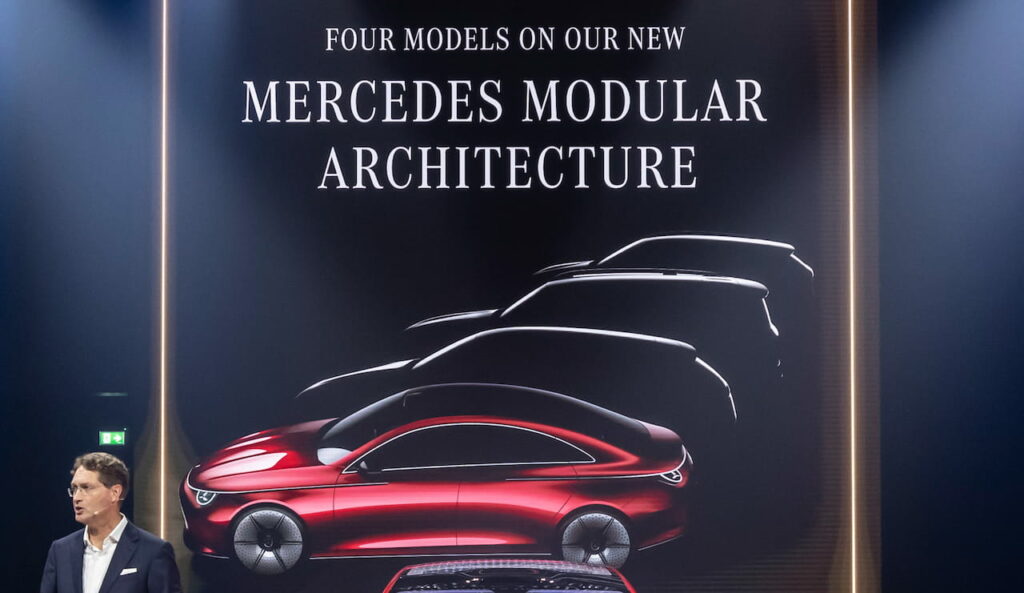
Furthermore, the GLA Electric’s LFP battery pack may consist of Chinese supplier CATL’s new ‘Shenxing’ batteries, the world’s first 4C superfast charging LFP batteries. Shenxing batteries can be charged to 80% level in just 10 minutes, and that capacity is enough to achieve a range of 400 km or 249 miles (presumably as per CLTC). Even in a -10ºC (14ºF) temperature, they can be charged from 10 to 80% in just 30 minutes. When fully charged, Shenxing batteries can endow an EV with a range of over 700 km or 435 miles (presumably as per CLTC).
In early September 2023, multiple publications reported that the LFP variant of the CLA Electric would have BYD Blade batteries. This could also imply the same for the future GLA Electric. However, these claims are based on CBEA‘s report which states that Mercedes-Benz “has publicly announced that it will assemble Blade batteries,” and we haven’t come across such an announcement yet. The CBEA report also states a generalized speculation that the CLA Electric “is expected to be equipped with lithium iron phosphate batteries from BYD.”
Charging
Thanks to their 800-volt architecture, MMA platform-based EVs will charge twice as fast, Källenius said on the eve of IAA 2023. While the EQA takes 32 minutes for a 10-80% DC fast-charging session, the GLA Electric may accomplish that in ~15 minutes. The EQA’s successor would support bi-directional charging as well, allowing customers to use vehicle-to-home (V2H), vehicle-to-vehicle (V2V), and vehicle-to-grid (V2G) functions.
Interior
‘MBUX Superscreen’ full-width display to revolutionize user experience
MMA platform EVs from Mercedes-Benz Group will arrive with a display stretching across the entire dashboard, JESMB said in a report published on January 17, 2023, citing confirmation by the German automaker. Fast-forward to September 3, 2023, the Mercedes Concept CLA Class breaks cover with a similar display called ‘MBUX Superscreen,’ a panel integrated three mini-LED displays with thousands of local dimming zones.
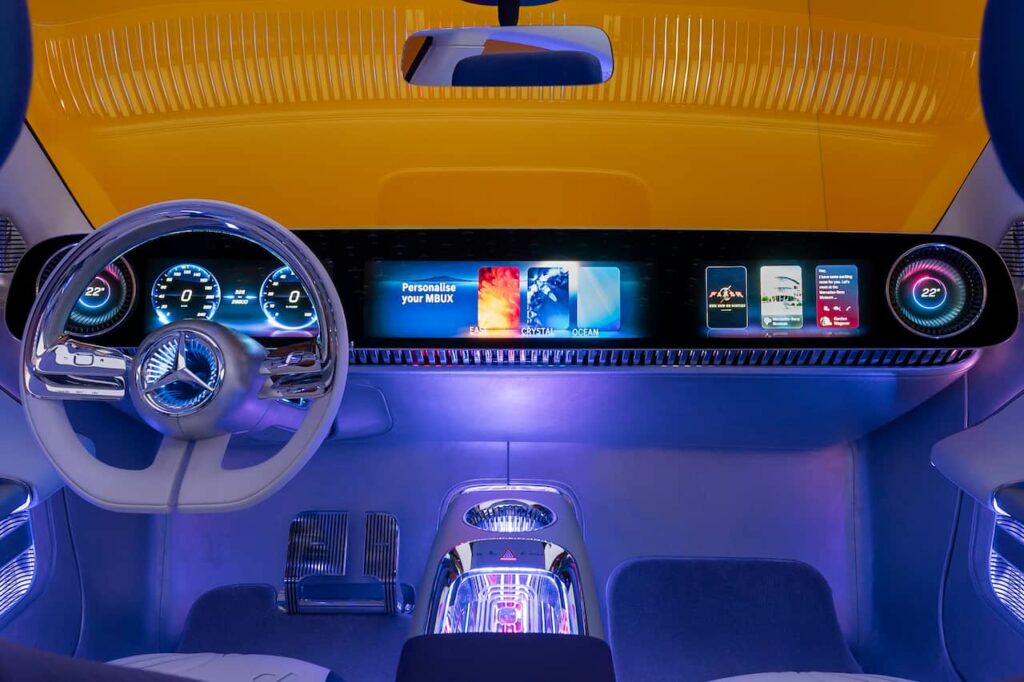
Since the Mercedes GLA Electric is one of the four models in the brand’s MMA (explained in the next section) line-up, it should be in line to receive the so-called MBUX Superscreen, which is similar to the MBUX Hyperscreen offered on the bigger EQ products.
Under the seamless single glass panel are three individual sections of the screen that comprise the instrument cluster, the main infotainment system, and a secondary display for the front passenger. MBUX Superscreen will likely only be offered in top trim levels of the GLA Electric.
MMA platform EVs will fully run on an in-house operating system called ‘MB.OS.’ This software will bring great passenger entertainment, including a variety of third-party video streaming options, which will be available only to the front passenger during the drive.
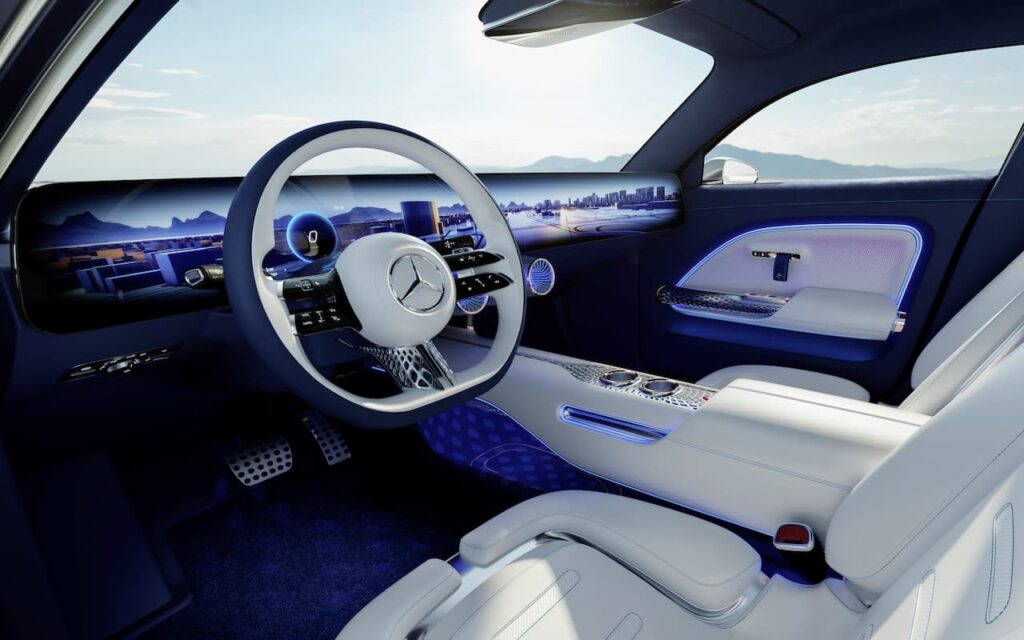
Autonomous driving features
The sensor set of the GLA Electric for its advanced driver assistance system functions should include a LiDAR sensor. A SAE Level 2 semi-automated driving system will likely offer the driver to take over driving on multi-lane roads (eg. highways) and maneuver the EV into and out of tight parking spaces automatically.
Sustainable materials
The Mercedes GLA Electric is likely to see greater usage of sustainable materials and contribute strongly towards Mercedes-Benz Group’s Ambition 2039 goal of having a CO2-neutral fleet. The company is uncovering new eco-friendly solutions for materials to be used in the car’s interior, body and body shell. The GLA Electric could be the early beneficiary of the new sustainability measures.
Interior
Sustainably processed genuine leather, animal-free genuine leather alternatives like cactus-based Deserttex, nylon yarn coming from recycled carpets and recycled fishing nets, natural fibers, etc., are the future of vehicle interior at Mercedes-Benz Group. The company is now commercializing some of them. For instance, it uses nylon yarn to make the Mercedes EQS’ floor coverings. For others, it’s showcasing them in concept cars as it continues researching. The Vision EQXX featured Deserttex and carpets made from 100% bamboo fiber.
Exterior
Mercedes-Benz Group is amping up sustainability for the body and body shell by switching to almost completely CO2-free steel from 2025. The new steel will be manufactured using hydrogen instead of coking coal. The company is trying to decarbonize aluminum production, too. The Mercedes-AMG SL’s structural castings come from die-cast alloys made from as high as 100% recycled aluminum scrap, which means 90% or more savings in CO2 emissions.
Mercedes-Benz Entry Luxury plan
Mercedes-Benz Group categorizes its compact Mercedes-Benz models as Entry Luxury products. On May 19, 2022, it announced plans to trim its model variants in the Entry Luxury segment from seven to four. The contribution of the Entry Luxury models to Mercedes-Benz sales has declined from 680,000 units in 2019 to 570,000 in 2021, and it could continue falling. Hence the decision to trim the line-up. However, the company expects profit margins to improve by 2026.
We will introduce four new models developed from scratch on our new Mercedes Modular Architecture (MMA): a four-door coupe, a shooting brake, and two stunning SUVs.
Ola Källenius, CEO, Mercedes-Benz Group (IAA 2023 Pre-Night event at the Mercedes-Benz Pavilion on September 3, 2023)
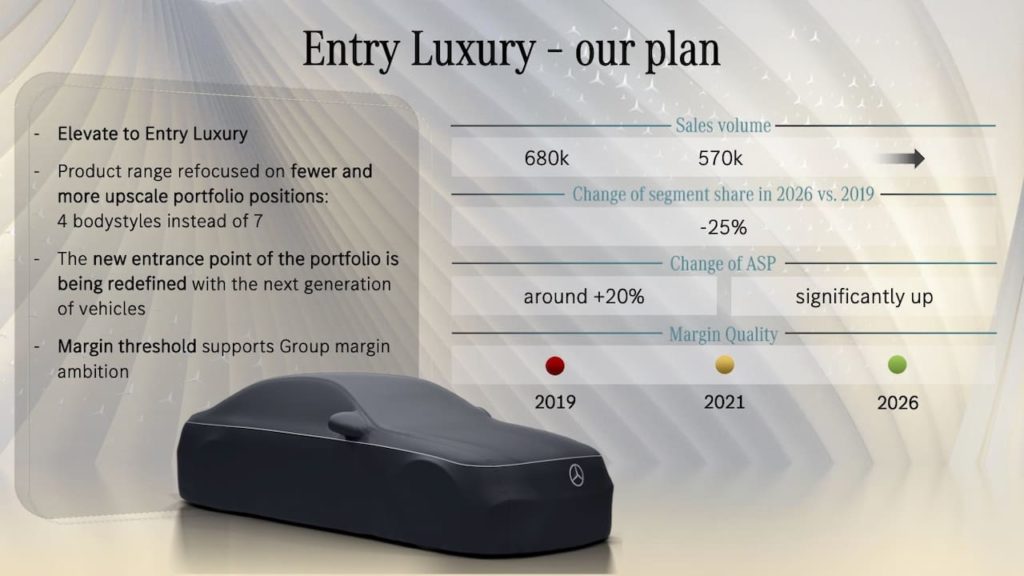
Mercedes could drop the EQ branding for the new EQA & EQB
Future electric cars from Mercedes will ditch the ‘EQ’ branding in the future, as per a Handelsblatt report published on January 12, 2023. The rebranding could result in the next-gen EQA and next-gen EQB ‘Entry Luxury’ models arriving as the Mercedes GLA Electric and Mercedes GLB Electric, respectively.
Since the company has decided to move to an all-electric line-up in select markets by 2030, a dedicated EV sub-brand would become redundant, the German newspaper report added. Using a single nomenclature for all future models would help the company mitigate brand confusion. Mercedes-Benz Group is yet to confirm this development, but it’s interesting to note that ‘EQ’ didn’t appear in the Concept CLA Class’s branding.
Mercedes GLA Electric FAQs
What is the Mercedes GLA Electric release date?
We expect the Mercedes GLA Electric to be launched in Europe in 2025.
What will be the Mercedes GLA Electric price?
The Mercedes GLA Electric’s prices in Germany should start at around EUR 50,000.
Which models will be Mercedes GLA Electric rivals?
The EQA’s successor will compete with the likes of Volvo XC40 Recharge and BMW iX1.
Featured Image Source: Mercedes-Benz Group
